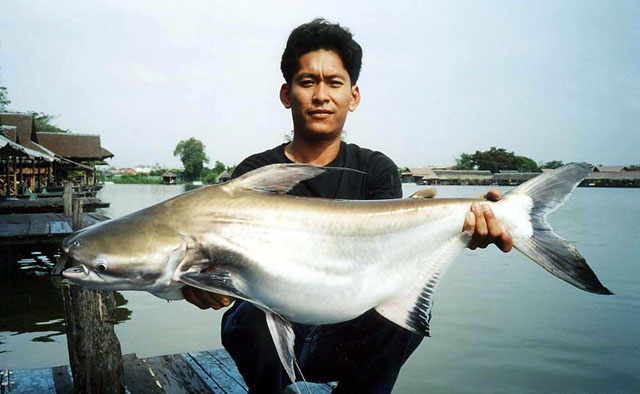| Pangasiidae (Shark catfishes) |
| 300 cm SL (male/unsexed); max.weight: 300 kg |
|
benthopelagic; freshwater, potamodromous |
| Asia: Chao Phraya and Mekong basins. |
|
Fins are pigmented with dusky melanophores. First soft ray in dorsal, pectoral and pelvic fins prolonged into a filament (Ref. 4792). Broad head; black tips on first few anal-fin rays in individuals of all sizes, particularly in juveniles; palatine and vomerine teeth united into a single long crescentic patch (Ref. 12693). Mouth wide, its width 5.5-5.9 times in SL (Ref. 43281). |
| Inhabits large rivers. Juveniles are found in larger tributaries (Ref. 58784). Both young and adults feeds on fishes and crustaceans (Ref. 12693). Larger individuals have been known to feed on carcasses of fowl or dog (which are commonly used for bait) (Ref. 7432). A migratory species (Ref. 37772). Spawns just before the rainy season and the young of the year reach a length of about 10 cm by mid-June (Ref. 12693). Fishery used to be accompanied by rites and ceremonies of a religious nature (Ref 2686). Important food fish and is often referred to in textbooks and popular press or news media (Ref. 4537). Marketed fresh (Ref. 12693). Threatened due to over harvesting, habitat loss and pollution (Ref. 58490). |
|
Critically Endangered (CR); Date assessed: 01 March 2007 (A2acd) Ref. (130435)
|
| harmless |
|
Known from Mekong and Chao Phraya basins (Ref. 26336). Reported from Phra Nakhon Si Ayutthaya, Nong Khai, Nakhon Ratchasima, Chiang Mai, Ubon Ratchathani, and Lop Buri river (Ref. 37773). Threatened due to habitat loss and overfishing; extirpated in the Chao Phraya (Ref. 58784). Museum: Mekong river, CAS 67212 (Bungkla, 140 km nw of Nakhon Phanom); CAS 67213 (mainstream at Bung Kan) (Ref. 5515). Also Ref. 1632, 9648, 37773, 45563.
Status of threat: Endangered (Ref. 58784). |
Source and more info: www.fishbase.org. For personal, classroom, and other internal use only. Not for publication.

